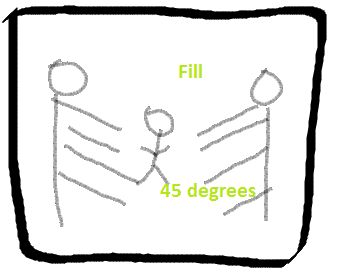Definition:
The(PRACTICAL PERFORMING SPACE) physical part of the space where the performance takes place
What things are important when choosing a performance space:
- Natural vs technical light
- Size of audience
- Live sound technical sound
- Acoustics of the space
- Access to backstage
Stage Types:
Proscenium
- Defined by stage and audience
- Proscenium arch
- 4th wall
- Projected outwards
- Particular angle always
- They are viewing it
- Distinction and contrast between audience and actors
- Never quite involved
- Intimacy is moderate
- Wing space
- Curtains
- All lot of options for set design
- Backdrop (and back curtain)
- Audience positioned in front of the stage
- Limited view
- Size can be very large/ usually moderate to large
Thrust (Catwalk)
- Audience on three sides
- The stage thrusts itself in the audience
- One distinct wall
- Increases intimacy
- You feel more involved
- Large limitations in terms of setting and props
- Like Illyria
- Can be small or large
- Can combine thrust and proscenium
- Limitations in terms of exits and entrances
Theatre in the round
- Large-scale picture but usually it is on a small scale
- Stage is centered and the audience is around the stage
- Extremely intimate
- You see everything that goes on on stage
- You see the reactions of everyone else on stage
- The audience members work as a guide for the emotions which build us up
- It is very engaging
- Limitations
- Lights from 360 degrees they do not cast a shadow
- Someone will always be looking at your back
- Setting
- Cannot have orchestra
- All are technical sound
- You can do whatever you want with the height of your stage
- Entrances and exits of the actors through the audience
- Something very intimate and very character based
Traverse
- A catwalk or runway
- Audience members on two opposing sides
- Good for entrances and exits of the characters
- Very powerful entrances and exits
- Or good for very aesthetic types of performances
- Bar splitting the stage into two
- Trainstation and audience very involved the train never came
- No backstage
- It is usually sth you would add to a stage
Arena
- They are about spectacles
- They are not intimate at all
- Grand and spectacular
- The excitement and extravagance of the performance
- Disney on ice
- Cirque du Soleil
- Tens of thousands
- Camera projection about details
- Not Intimate
- Largeness and spectacle nature of the performance
- No audience involvement
- Disconnection and spectacle
- Complete opposite from the theatre in the round
Black Box (Studio)
- Curtains all around
- Full space of imagination
- Any type of stage
- Limitless in the options for a black box
- Usually, workshops take place in a black box
Platform
- Elevated platform where the performance takes place
- Very traveling
- Improv
- Daily traveling
- Very impromptu
- Unprofessional
Rake
- On an angle
- Shakespeare
- Visuals
- The whole performance can be seen
- It increases the visibility
- You can have that in a proscenium stage thrust and arena
- You can rake your audience
Hippodrome
- For horse races
- Big penis shaped
- Horse racing track
- You can still use it
- Small-scale them put them inside
- Horses come from one side
- Elongated semi-circle
Open Air
- Just outside
- uses the nature
- Uses sunsets and sunrises
- Instant form of setting
- Symbolic use of nature
- Impactful
- Theatre of cruelty in the open air
- Not very technical
Promenade
- To take a walk
- Walking theatre
- Kind of like a flash mob
- Audience member is walking and moving
- They are being immersed
- You are part of the show
- Extremely immerse
- A guide takes you through
- Example last year’s monologues
- Performances being repeated constantly and the audience going around
- Used intentionally
- Very immersive
- Lighting and sound limitations
- Intimacy and involvement is high
Site-specific
- You choose the location for its purpose
- Literally on a location
- Purposefully as part of your performance
- Example colonial house









 Thunderstorm by Lei Yu in 1933
Thunderstorm by Lei Yu in 1933 Sunrise by Ri Chu in 1936
Sunrise by Ri Chu in 1936
 Bus Stop/Station by Che Zhan in 1981
Bus Stop/Station by Che Zhan in 1981

